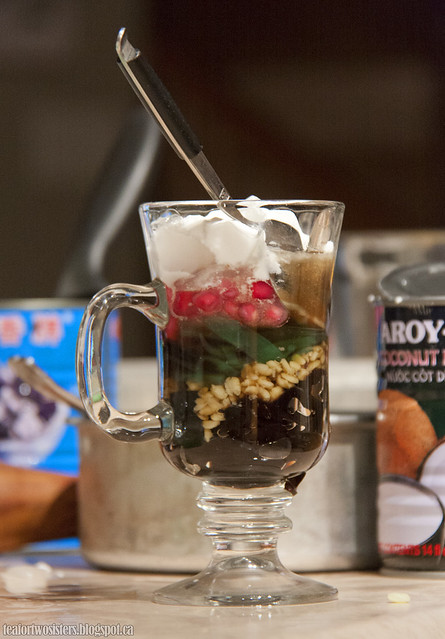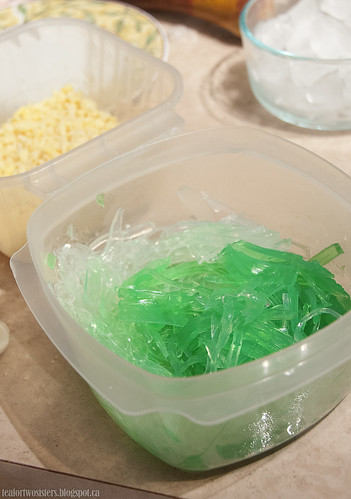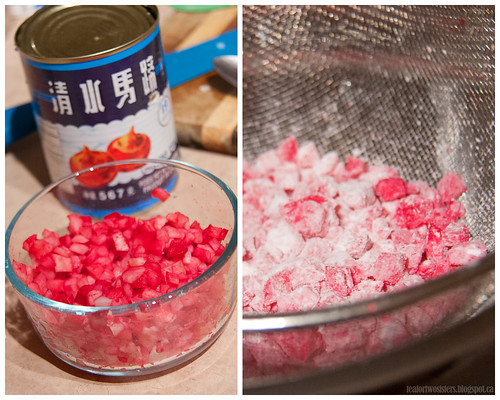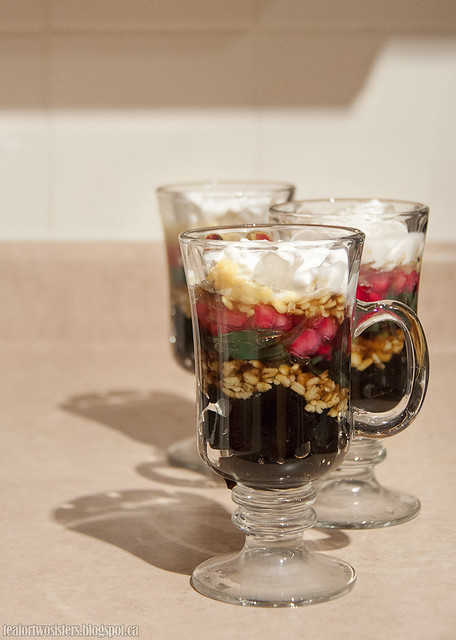
Che Suong Sa Hot Luu:
Water chestnuts, tapioca starch, palm sugar, water, mung beans, grass jelly, agar agar jelly, coconut milk
At home, I cooked the mung beans in the rice cooker and brought them over. It started with one cup of mung beans. They were carefully sorted through a few times to make sure all the small pebbles were out. Then the mung beans were left to soak in cool tap water for about ten minutes. After they briefly soaked, the mung beans were rubbed between the hands to get rid of the skins and rinsed a few times until the water ran clear and not yellow. The water was then drained out and measured out to a ratio of two parts water to one part mung beans. They were cooked in the rice cooker and then allowed to cool.
The agar agar jelly was made with a small envelope of agar agar (25g) to six to seven rice bowls of water but I originally used five rice bowls. First I added four and a half rice bowls of water into a pot and brought it to a boil with two tablespoons of sugar. The remaining half bowl of water was used to dissolve the agar agar powder. Once the pot of water began to simmer, I added the dissolved powder into the pot. Mom reminded me to keep stirring the pot or else the bottom will burn. And so after the liquids boiled for a minute, the pot was taken off the heat to cool off a bit. When the liquid jelly was warm, they were poured into a baking pan to set and a container. A few drops of green food colouring was added to the container of agar agar jelly that I had planned to bring over. This is optional. Unfortunately the jelly was too firm, so the jelly was reheated and mixed with more water to produce a softer jelly. The jelly was almost crunchy with only five rice bowls of water. Gross, huh? When the jelly was finally set, it was shredded with one of our orange hand shredder/peelers.
With the two components done already, I boiled some water and cane sugar together to make the simple syrup once I got to VN's place. We didn't have palm sugar, or else we would've used that, but the cane sugar was a fine substitution. I think I used about one part of sugar to the same of water. I went by taste. The pot was allowed to cool off for a bit and then we covered it and placed it outside on the balcony to chill -- one perk in living in Ottawa; a giant outdoor fridge/freezer.
The agar agar jelly was made with a small envelope of agar agar (25g) to six to seven rice bowls of water but I originally used five rice bowls. First I added four and a half rice bowls of water into a pot and brought it to a boil with two tablespoons of sugar. The remaining half bowl of water was used to dissolve the agar agar powder. Once the pot of water began to simmer, I added the dissolved powder into the pot. Mom reminded me to keep stirring the pot or else the bottom will burn. And so after the liquids boiled for a minute, the pot was taken off the heat to cool off a bit. When the liquid jelly was warm, they were poured into a baking pan to set and a container. A few drops of green food colouring was added to the container of agar agar jelly that I had planned to bring over. This is optional. Unfortunately the jelly was too firm, so the jelly was reheated and mixed with more water to produce a softer jelly. The jelly was almost crunchy with only five rice bowls of water. Gross, huh? When the jelly was finally set, it was shredded with one of our orange hand shredder/peelers.
With the two components done already, I boiled some water and cane sugar together to make the simple syrup once I got to VN's place. We didn't have palm sugar, or else we would've used that, but the cane sugar was a fine substitution. I think I used about one part of sugar to the same of water. I went by taste. The pot was allowed to cool off for a bit and then we covered it and placed it outside on the balcony to chill -- one perk in living in Ottawa; a giant outdoor fridge/freezer.
If you've had this dessert before, you've most likely ate the small chewy and crisp red things that looked like pomegranate seeds. They're actually water chestnuts covered in tapioca starch. Does that blow your mind? My mind was blown to bits because I strongly dislike water chestnuts. I don't like them in cheung fan. I don't like them in stir-fries or dumpling fillings either, but they're so good in the dessert. I was surprised that I couldn't taste the water chestnuts at all. Anyway, neither VN or I have made it before. We were determined to try and make it anyway.
We rinsed out the water chestnuts and then diced them. The diced water chestnuts were mixed with red food colouring and were then tossed with tapioca starch. VN flicked some water onto the water chestnuts while tossing them in the wire strainer. We broke up the pieces that were stuck and then tossed the moist water chestnuts with more tapioca starch. VN repeated those steps about five times to get a good layer of tapioca starch.
A pot of boiling water cooked the tapioca starch-covered water chestnuts in batches. We didn't want them to clump together, so while I stirred the hot water, VN slowly added the water chestnuts in. After they floated for about two minutes, I took them out and placed them in a bowl of ice water to stop the cooking process. I gave the cooked little nuggets a taste. It definitely tasted water chestnut-y. The tapioca starch coating was great though. I definitely suggest that you do at least four layers of tapioca starch.
Along with a cold can of grass jelly and coconut milk, we put the dessert together: grass jelly, mung beans, green agar agar jelly, white agar agar jelly (though you can't really see them), tapioca starch-covered water chestnuts, more mung beans, ice, and coconut milk. In hindsight, maybe we should've started with a base of mung beans and then grass jelly for a nicer look.
This wasn't as delicious as the one I had in Vietnam. But it was pretty good for a first time attempt. To get rid of the water chestnut taste, I think that soaking the water chestnuts in water might get rid of their taste. I would've preferred more coconut milk in my glass since I love coconut milk. I guess it's just the ratio of everything that was a bit off.
When I ate it the next day, I warmed up the coconut milk in a saucepan so it turned into a liquid again. The coconut milk was chilled and so the coconut cream clumped up when we added it to the glasses of che. The che tasted so much better with the warmed coconut milk! The water chestnuts no longer tasted as strong either. Not because of the coconut milk, but because I dumped the water chestnuts, mung beans, and palm sugar together and kept it in the fridge overnight.
In any case, this is one of those desserts where you can personalize them to your taste. Do you like more grass jelly? Fine, add more. You don't like the green agar agar jelly? Leave them out. People can put together their own glass of che suong sa hot luu. It's a great party dessert for that reason.
This wasn't as delicious as the one I had in Vietnam. But it was pretty good for a first time attempt. To get rid of the water chestnut taste, I think that soaking the water chestnuts in water might get rid of their taste. I would've preferred more coconut milk in my glass since I love coconut milk. I guess it's just the ratio of everything that was a bit off.
When I ate it the next day, I warmed up the coconut milk in a saucepan so it turned into a liquid again. The coconut milk was chilled and so the coconut cream clumped up when we added it to the glasses of che. The che tasted so much better with the warmed coconut milk! The water chestnuts no longer tasted as strong either. Not because of the coconut milk, but because I dumped the water chestnuts, mung beans, and palm sugar together and kept it in the fridge overnight.
In any case, this is one of those desserts where you can personalize them to your taste. Do you like more grass jelly? Fine, add more. You don't like the green agar agar jelly? Leave them out. People can put together their own glass of che suong sa hot luu. It's a great party dessert for that reason.



Sounds delicious! Whenever I go to Vietnamese restaurants I always get this dessert beverage (but maybe it's more of a dessert than a beverage) and it sounds like this, only without the grass jelly and the water chestnuts. They also add a lot of coconut milk.
ReplyDeleteIt's an amazing dessert in the summer, especially when you get the ratios right! Oh, I forgot to mention, but I think shaving the ice or having finely crushed ice elevates the experience. The water chestnuts take more time to make, so I doubt many Vietnamese restaurants will go that far. My Vietnamese aunt uses shredded seaweed instead of grass jelly. I prefer the grass jelly. lol
ReplyDelete